If a person has worked hard, played sports intensely, or walked a long distance, at reflex level, they place their hand on their lower back when they stop and relax. It is this part of the body that pulls and hurts after exertion, which is explained very simply. The spine is the main support of the human bone skeleton. It connects all the joints and takes most of the stress out of any movement. So it's quite natural that, after work or sports, the lower back aches and aches.
But not always the causes of back pain in the lower back are overwork. Low back pain is often a symptom of serious disorders in the human body; it cannot be ignored, especially if the pain is severe and often repeated. This is a sign that an unknown pathology is already progressing and is causing more and more damage to the body every day. It is recommended to see a doctor as soon as possible: neglected back problems are difficult to treat and can end up in a wheelchair for the patient.
It's interesting:Researchers believe that low back pain in the spine is a consequence of human evolution and, more precisely, bipedal locomotion. In animals that move on four limbs, loads are evenly distributed. One has to pay for actual posture and ability to walk on two legs with violation of load distribution, curvature of the vertebrae and back pain.
what can be back pain
Your back can hurt in different ways. Sometimes the pain is sharp, unbearable, the patient feels an unbearable burning sensation and a severe limitation of mobility. More often, patients complain of pain in the lower back, pulling, unpleasant sensations that usually appear at night, may wake up in the middle of the night, intensify when the weather changes or after physical exertion.
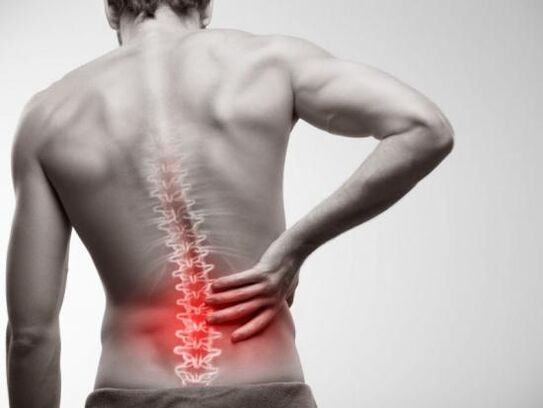
Morning stiffness of the spine, back pain "for the weather" and after exercise are the first signs that joints are damaged.
Back pain is always accompanied by additional symptoms, which you should definitely pay attention to and inform your doctor of your observations. According to the accompanying signs, it will be easier to establish the true cause of the pain in the lower back. So what symptoms and criteria will be of diagnostic value:
- Duration (severity) of pain. It's called acute pain syndrome, which worries up to three months. If it occurs periodically for four months or more, it is of variable intensity, then it is already referred to as chronic.
- Location. Low back pain radiating to the buttocks is commonly referred to as lumbodynia in medicine. If the pain affects the leg, it's lumbar sciatic pain. Also, unpleasant sensations can only occur on the right, on the left, or on both sides at the same time.
- The nature of pain. This criterion is of fundamental importance. The pain can be sharp and localized in one point, it can be projected in the limbs, buttocks, groin, hypochondrium or lower abdomen. Pain is strong, dull or throbbing. The most difficult thing is to make a correct diagnosis for combined pain.
- Effects on joint mobility. The doctor will definitely clarify whether there is stiffness in the spine, limbs, hip joint, under what circumstances, for how long it lasts.
- Time indicator. It is also important when and after which your back starts to hurt. This happens all the time, in the morning, at night, at night, after exertion, when turning the head, walking, bending, etc. - the answers to all these questions are extremely important for the correct diagnosis.
On a note:according to doctors' statistics, more than 80% of the population in Europe has experienced back pain at least once in their lifetime. More than 25% of medical appointments are caused by discomfort and pain in the lower back. Furthermore, 8 out of 10 patients are active young people, with a productive age of 35 to 45 years. Less often, retirees complain of back pain, and even less often teenagers.
The reasons
All causes of low back pain can be divided into two broad categories:
- physiological, usually caused by external factors;
- pathological, associated with diseases of Organs internal organs.
Physiological reasons include:
- excessive physical activity when playing sports;
- lifting and carrying weights at work or in training;
- hard work at home or in the field;
- hypothermia, prolonged stay in a damp room.

Age combined with physical work are sufficient reasons for low back pain.
The pathological causes of back pain, in turn, may be associated with diseases of the spine or changes in its structures related to age - this painful syndrome is called primary. If the back pain is caused by dysfunctions of other organs, eg the kidneys, it is called secondary - in this case, it will be necessary to establish the background disease with the help of additional specific studies and treat two pathologies simultaneously.
Diseases and conditions where the lower back can hurt:
- Osteochondrosis (spondylosis) - before it was diagnosed mainly in the elderly, now it is detected at any age;
- intervertebral hernia - also occurs at any age, if in young people, usually after excessive strength sports;
- neuralgia of a different nature;
- arthritis and arthrosis, any inflammatory process of the joints;
- rheumatism and other autoimmune diseases;
- radiculitis;
- endocrine system dysfunction (diabetes mellitus, hyperthyroidism);
- inflammation of the renal pelvis - pyelonephritis;
- inflammation of Organs genitourinary organs.
Back or limb injuries are also painful. To determine the exact cause, you will need to undergo a series of tests, the minimum mandatory is an external examination by a specialist, laboratory tests of urine and blood, X-ray, electrocardiogram, ultrasound of the kidneys and genitourinary organs. If necessary, additional diagnostic measures will be assigned.
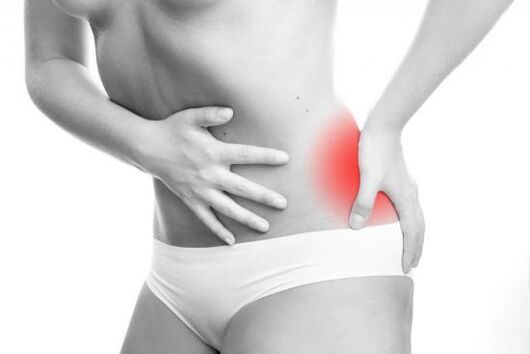
In women, back pain can be caused by cystitis or inflammation of the adnexa.
Spine Diseases as a Cause of Back Pain
If the x-ray shows deformation of the vertebrae, their compaction and expansion with the formation of bone bulges in the form of spines at the edges, the doctor diagnoses osteochondrosis or spondylosis. Until recently, this pathology was considered a disease of retirees, and its main cause was the so-called natural changes in the body related to age, deceleration of metabolic processes and wear of the vertebrae.
It is now proven that osteochondrosis can be triggered by a number of other factors in young people and even adolescents. The impetus for degenerative changes in the vertebrae and intervertebral discs are:
- insufficient physical activity with excess weight or due to chronic diseases that limit mobility;
- sedentary work;
- metabolic disturbances during diet, for example, as a result of which vertebral structures do not receive enough nutrients and wear out prematurely;
- inappropriate sports - no warming up of muscles and ligaments, no gradual increase in loads and control of lifting loads.
With osteochondrosis, as it progresses, the intervertebral discs deform - they become flat, dense, and rough. The affected disc can easily trap the nerve root, which branches into the spine, causing inflammation. Also, the nerve roots are damaged by bone spine processes. The patient experiences this as a sharp, sharp pain, along with which there is limited mobility in the lower back. This condition is called sciatica.

In spondylosis, bone growths along the edges of the vertebrae damage the nerve roots and thus cause acute pain syndrome.
Inflammatory processes in the spine can begin to develop as early as adolescence and adolescence. It manifests as recurrent back pain, sometimes disturbing at night. They are then accompanied by morning stiffness, fatigue, and decreased physical activity. In advanced stages, the spine becomes severely deformed, a person's posture and gait changes, and a hump is formed. Rheumatoid arthritis can develop over years, in some cases up to ten years. As the course of the disease is slow, symptoms are often cloudy, the patient does not go to the doctor, trying to deal with the discomfort with improvised means. For this reason, inflammation of the vertebral joints more often than other pathologies leads to deficiency.
If the patient during the research mentions discomfort in other joints (shoulder, foot, knee, hand), complains of pain in the buttocks, decreased visual acuity, fecal disturbances, spondyloarthritis, it can be suspected. A rheumatologist is committed to the treatment of this pathology, your consultation is needed immediately, as the pathology progresses quickly and leads to irreversible changes in bone and joint structures.
Non-Back Related Diseases as a Cause of Pain
Pain in the lower back sometimes causes disease in organs that at first glance have nothing to do with the spine. Myofascial pain syndrome is a common cause of back pain that is not accompanied by other symptoms of joint pathologies. Typically, young women come to the doctor with complaints of back pain after a day at work, intense training in the gym or long stay in the same position.
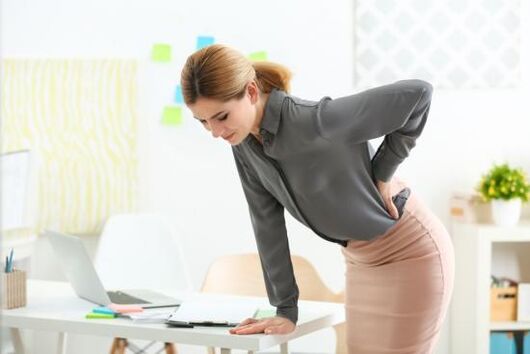
Pain in myofascial syndrome is not associated with spinal joint damage and is easily eliminated by pain relievers, massage, and NSAIDs.
During the exam, the doctor can easily detect points near the spine, when pressure is applied and where pain occurs. Pain is caused by overexertion of muscle tissue, nerve roots and joint elements do not suffer. This condition does not pose a major threat to the patient's health, but it can significantly reduce the quality of life. For treatment, the doctor prescribes muscle relaxants - drugs that promote muscle relaxation, as well as nonsteroidal anti-inflammatory drugs in a short course in minimal dosages. It is recommended to adjust the rest and sleep regimen and to monitor physical activity.
Other extra-articular pathologies that can also be accompanied by back pain:
- Cholecystitis and pancreatitis. The pain is located in the right hypochondrium and can be projected into the lower right back.
- Appendicitis. In some cases, sharp, stabbing pains radiate to the lower back, also on the right side. Additional symptoms of appendix inflammation: swelling, stool disturbances, nausea, vomiting, intense pallor, fever.
- Renal dysfunction, urolithiasis. Depending on which kidney is inflamed, pain will occur in the right or left lower back. If a stone comes out with urolithiasis, the lower back also hurts a lot; in difficult cases, body temperature may rise.
- Obesity. With excess body weight, heavy loads are placed on the lumbar spine, which causes back pain and discomfort.
- Osteomyelitis. Bone infections are accompanied by severe pain and fever.
If during the examination no visible lesions of the spine or other joints were found, and no disease of Organs internal organs was detected, it makes sense to donate blood for tumor markers and perform an MRI of the spine. Malignant tumors, when they grow, put pressure on the nerve roots and also become the cause of pain. Pain syndrome is characteristic of stage 3-4 cancer.
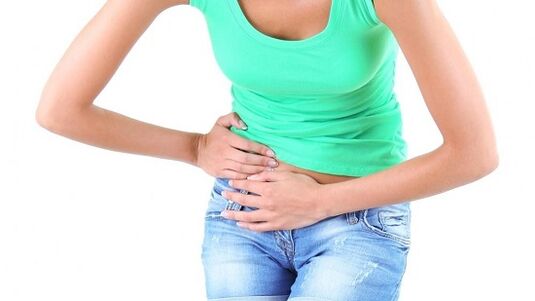
Pain in the lower back can be a symptom of appendicitis.
Why do women's backs hurt
If women have severe back pain in the lower back, you should first review your individual calendar. Pulling pains may be uncomfortable before menstruation, at the same time pulling the lower abdomen, swelling of the mammary glands, the patient is nauseated, some are plagued by migraines, food intolerance, or, conversely, gluttony.
Almost the same symptoms are signs of pregnancy. So if your period has not started for several days and the pain and discomfort persist, it makes sense to take a pregnancy test and make an appointment with a gynecologist.
Also, the cause could be gynecological diseases. Annexitis usually manifests as pain in the lower abdomen. But sometimes they radiate to the lower back. Similar sensations occur when ovarian cysts are twisted. With the onset of menopause, many women complain of a burning sensation in the lower back, stiffness. In any case, a therapist or rheumatologist will advise you to see a gynecologist.
Causes of pain in men
In men, the back hurts mainly from professional activities - hours of driving, working at a computer, lifting and carrying weights, professional sports.
But pain in the right or left side of the back can also be one of the symptoms of prostatitis or a condition such as epididymitis. To exclude or confirm pathologies, you need to be examined by an andrologist.

Men with back pain should definitely see an andrologist to rule out prostatitis.
When and what treatment is needed
Even with very severe and persistent back pain, most patients do not believe they need serious treatment and expect only one thing from the doctor - a good pain reliever to help immediately and for a long time. Unfortunately, this medicine does not exist. The pain syndrome can be extinguished with injections and pills, but the effect will not be long-term as the cause of the discomfort will not be eliminated. Treatment methods will be determined depending on what triggered the back pain.
Bruises and muscle sprains
The first thing to do is give your back a complete rest. This means you can't play sports, lift weights, stand a lot, walk, run, jump, and cool off. It is recommended to get rid of the extra pounds, with sedentary work and an inactive lifestyle, instead you should think about saving sports - for example, yoga, Pilates, swimming. In the future, you will have to reconsider your habits and adjust the load on your spine.
What to do before visiting the doctor:
- taking a pain reliever or non-steroidal anti-inflammatory drug in a minimal dosage;
- fix your lower back with a makeshift corset—a towel or scarf;
- to reduce swelling, drink herbal tea with a diuretic effect.
What the doctor will advise:
- short-acting nonsteroidal anti-inflammatory drugs;
- muscle relaxants to relieve muscle spasm and tension;
- back massage and warming (in the absence of inflammatory processes);
- B vitamins.
If you follow all the recommendations, the pain will completely disappear in 7 to 14 days.
To remember!If an increase in body temperature is detected, there is pain in the leg or other parts of the body, mobility is limited, or other atypical symptoms occur, in no case should you seek the help of a chiropractor, warm up or massage yourself. It is also not recommended to take painkillers as this will complicate the diagnosis.
Spine pathology
Early joint diseases are treated with the same techniques as for bruises or other injuries. In addition, doctors may prescribe chondroprotective drugs - drugs that protect joint structures from destruction and encourage their recovery.
For spinal compression fractures, extensive intervertebral disc hernias, severe forms of osteochondrosis or spondyloarthritis, surgical intervention is indicated. Depending on the violation detected, the operation can be simple and performed under local anesthesia or in several stages over a six-month period. After an operation of any complexity, it will be necessary to take antibiotics, use a dressing and physiotherapy for complete rehabilitation.

Modern technologies allow performing minimally invasive interventions in the spine with minimal risk of complications.
Today, spine surgeries are no longer exceptional, a rich and varied experience has been accumulated, and there are special equipment that allow you to solve almost any problem. Therefore, if the situation is difficult and the doctor has recommended an operation, there is no point in delaying it. The sooner it is done, the more chances you will have complete pain relief and restoration of spinal function.
Helpful Tips
Timely and effective treatment of low back pain is often difficult for an extremely common reason - the patient does not know which doctor to see. If the pain was preceded by an injury, everything is simple - you need to see a traumatologist. He will likely prescribe painkillers and a course of nonsteroidal anti-inflammatory drugs, and then recommend various physical therapy procedures - electrophoresis, magnetotherapy, massage, and exercise therapy. This is the standard treatment for back injuries.
The difficulty is that, when being hit or falling, the nerve endings can be affected. And then you need to involve a neurologist who will recommend their own treatment methods. A rheumatologist or orthopedist will have their own opinion. And if, during the examination, the pathology of any of Organs internal organs is revealed, for example, the genitourinary system, the patient will be completely confused about what needs to be treated and to whom to listen. In fact, it is for this reason that many people abandon the methods of official medicine and turn to non-traditional ones, that is, folk remedies, which ends up worsening the condition and developing complications.
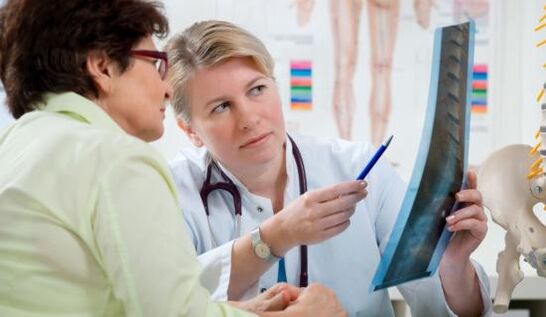
It turns out that doctors make the wrong diagnosis and prescribe the wrong treatment, which leads to disease progression and complications.
What to do in such a situation? Don't panic or be in a hurry, but follow the prescribed course of treatment to the end, focusing on your own feelings and well-being. If, after two to four weeks, your back hurts so much and there is no improvement at all, it makes sense to see another doctor and have a second test to review the correctness of the diagnosis. Switching from one analgesic to another and, instead of electrophoresis, it makes no sense to do UHF.
As for the treatment of the back with homeopathic remedies at home, here too, you should not get carried away and irresponsibly believe in the promises of traditional healers. A suitable adult person must understand: traditional methods of treatment are good in the remission phase, when the condition is stable, or for the prevention of relapses and complications. Rheumatoid arthritis, for example, as an autoimmune disease, herbal tinctures cannot cure at all.

Medicinal plants are helpful in improving the overall tone of the body, but they are hardly helpful in the case of a hernia, disc dislocation, or compression fracture.
The right decision would be if your lower back constantly hurts and medical appointments at the district clinic are ineffective - go to a reputable private clinic and have an examination there. It's not free, but you'll find out the real reason and you'll be able to start the right treatment, and not try folk remedies and conventional pain relievers that have no therapeutic effect.
Summary:Almost all adults experience back pain at least once in their lifetime. In fact, there can be a number of reasons: from trivial overwork to serious pathologies of the spine, kidneys, infection or metabolic disturbances in the body. It is important to accurately and correctly establish the cause and start appropriate treatment as soon as possible. The spine is the main joint of the human skeleton, its dysfunction and destruction in the absence of adequate medical care will inevitably lead to loss of mobility and disability.































